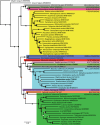Complete mitochondrial genomes of three vulnerable cave bat species and their phylogenetic relationships within the order Chiroptera
- PMID: 39172941
- PMCID: PMC11340975
- DOI: 10.1371/journal.pone.0308741
Complete mitochondrial genomes of three vulnerable cave bat species and their phylogenetic relationships within the order Chiroptera
Abstract
The IUCN Red List of Threatened Species contains 175 Brazilian bat species that are threatened by extinction in some degree. From this perspective, it is essential to expand the knowledge about the genetic diversity of vulnerable bats. Genomic sequencing can be useful to generate robust and informative genetic references, increasing resolution when analyzing relationships among populations, species, or higher taxonomic levels. In this study, we sequenced and characterized in detail the first complete mitochondrial genomes of Furipterus horrens, Lonchorhina aurita, and Natalus macrourus, and investigated their phylogenetic position based on amino acid sequences of protein-coding genes (PCGs). The mitogenomes of these species are 16,516, 16,697, and 16,668 bp in length, respectively, and each comprises 13 PCGs, 22 tRNA genes, two rRNA genes, and a putative control region (CR). In the three species, genes were arranged similarly to all other previously described bat mitogenomes, and nucleotide composition was also consistent with the reported range. The length and arrangement of rrnS and rrnL were also consistent with those of other bat species, showing a positive AT-skew and a negative GC-skew. Except for trnS1, for which we did not observe the DHU arm, all other tRNAs showed the cloverleaf secondary structure in the three species. In addition, the mitogenomes showed minor differences in start and stop codons, and in all PCGs, codons ending in adenine were more common compared to those ending in guanine. We found that PCGs of the three species use multiple codons to encode each amino acid, following the previously documented pattern. Furthermore, all PCGs are under purifying selection, with atp8 experiencing the most relaxed purifying selection. Considering the phylogenetic reconstruction, F. horrens was recovered as sister to Noctilio leporinus, L. aurita and Tonatia bidens shared a node within Phyllostomidae, and N. macrourus appeared as sister to Molossidae and Vespertilionidae.
Copyright: © 2024 Molina et al. This is an open access article distributed under the terms of the Creative Commons Attribution License, which permits unrestricted use, distribution, and reproduction in any medium, provided the original author and source are credited.
Conflict of interest statement
The authors declare no conflict of interest.
Figures



References
-
- Wilson DE, Mittermeier RA. Handbook of the Mammals of the World—Vol. 9, Bats. Barcelona: Lynx Editions; 2019. pp. 1008.
-
- Ferreiras RL, Martins RP. Trophic structure and natural history of bat guano invertebrate communities, with special reference to Brazilian caves. Trop Zool. 1999; 12:231–252.
-
- Kunz HK. De Torrez EB, Bauer DM, Labova TA, Fleming TH. Ecossystem services provided by bats. Ann New York Acad Sci. 2011; 1223:1–28. - PubMed
-
- Kunz TH. RoostIng ecology of bats, In: Kunz T. H. Ecology of bats. New York: Plenum Press; 1982. pp. 1–55.
-
- Rocha PA. Quiropterofauna cavernícola: composição, estrutura de comunidade, distribuição geográfica. M.Sc. Thesis, Programa de Pós-graduação em Ciências Biológicas, Universidade Federal da Paraíba. 2013.
MeSH terms
Substances
LinkOut - more resources
Full Text Sources
Miscellaneous

